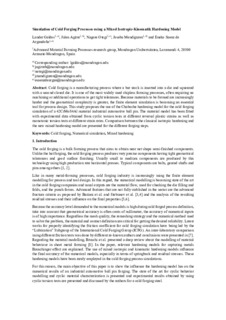| dc.contributor.author | GALDOS, Lander | |
| dc.contributor.author | Agirre, Julen | |
| dc.contributor.author | Otegi, Nagore | |
| dc.contributor.author | Mendiguren, Joseba | |
| dc.contributor.author | Sáenz de Argandoña, Eneko | |
| dc.date.accessioned | 2022-11-11T16:33:06Z | |
| dc.date.available | 2022-11-11T16:33:06Z | |
| dc.date.issued | 2021 | |
| dc.identifier.isbn | 978-3-030-75381-8 | en |
| dc.identifier.other | https://katalogoa.mondragon.edu/janium-bin/janium_login_opac.pl?find&ficha_no=165034 | en |
| dc.identifier.uri | https://hdl.handle.net/20.500.11984/5847 | |
| dc.description.abstract | Cold forging is a manufacturing process where a bar stock is inserted into a die and squeezed with a second closed die. It is one of the most widely used chipless forming processes, often requiring no machining or additional operations to get tight tolerances. Because materials to be formed are increasingly harder and the geometrical complexity is greater, the finite element simulation is becoming an essential tool for process design. This study proposes the use of the Chaboche hardening model for the cold forging simulation of a 42CrMoS4Al material industrial automotive ball pin. The material model has been fitted with experimental data obtained from cyclic torsion tests at different reversal plastic strains as well as monotonic torsion tests at different strain rates. Comparison between the classical isotropic hardening and the new mixed hardening model are presented for the different forging steps. | en |
| dc.description.sponsorship | Gobierno Vasco-Eusko Jaurlaritza | es |
| dc.description.sponsorship | Diputación Foral de Gipuzkoa | es |
| dc.language.iso | eng | en |
| dc.publisher | Springer | en |
| dc.rights | © 2021 The Minerals, Metals & Materials Society | en |
| dc.subject | Cold forging | en |
| dc.subject | Numerical simulation | en |
| dc.subject | Mixed hardening law | en |
| dc.title | Simulation of Cold Forging Processes Using a Mixed Isotropic-Kinematik Hardening Model | en |
| dcterms.accessRights | http://purl.org/coar/access_right/c_abf2 | en |
| dcterms.source | Forming the Future. The Minerals, Metals & Materials Series | en |
| local.contributor.group | Procesos avanzados de conformación de materiales | es |
| local.description.peerreviewed | true | en |
| local.description.publicationfirstpage | 773 | en |
| local.description.publicationlastpage | 787 | en |
| local.identifier.doi | https://doi.org/10.1007/978-3-030-75381-8_64 | en |
| local.relation.projectID | info:eu-repo/grantAgreement/GV/Elkartek 2018/KK-2018-00025/CAPV/Desarrollo de distintos métodos de alivio de tensiones residuales en chapas metálicas (2ª parte)/RELASHEET | en |
| local.relation.projectID | info:eu-repo/grantAgreement/DFG/ELKARLANA Programa para promover el fortalecimiento competitivo//GIP/Tecnologías base para la digitalización industrial/LANKIFOR | en |
| local.source.details | Daehn G., Cao J., Kinsey B., Tekkaya E., Vivek A., Yoshida Y. (eds). Pp. 773-787. Springer, 2021 | en |
| oaire.format.mimetype | application/pdf | |
| oaire.file | $DSPACE\assetstore | |
| oaire.resourceType | http://purl.org/coar/resource_type/c_c94f | en |
| oaire.version | http://purl.org/coar/version/c_ab4af688f83e57aa | en |







